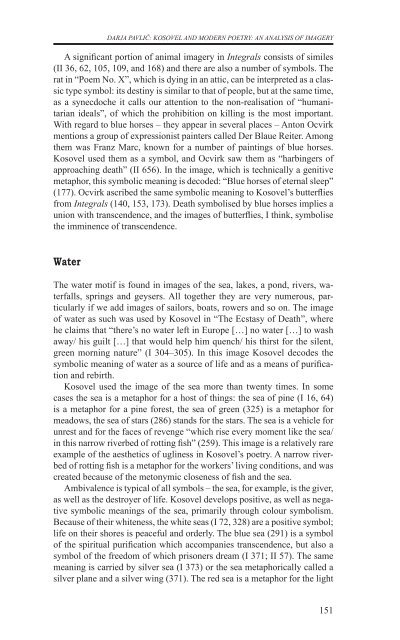razprave (pdf) - Društvo za primerjalno književnost - ZRC SAZU
razprave (pdf) - Društvo za primerjalno književnost - ZRC SAZU
razprave (pdf) - Društvo za primerjalno književnost - ZRC SAZU
- No tags were found...
You also want an ePaper? Increase the reach of your titles
YUMPU automatically turns print PDFs into web optimized ePapers that Google loves.
Darja pavlič: KOSOVEL AND MODERN POETRY: AN ANALYSIS OF IMAGERYA significant portion of animal imagery in Integrals consists of similes(II 36, 62, 105, 109, and 168) and there are also a number of symbols. Therat in “Poem No. X”, which is dying in an attic, can be interpreted as a classictype symbol: its destiny is similar to that of people, but at the same time,as a synecdoche it calls our attention to the non-realisation of “humanitarianideals”, of which the prohibition on killing is the most important.With regard to blue horses – they appear in several places – Anton Ocvirkmentions a group of expressionist painters called Der Blaue Reiter. Amongthem was Franz Marc, known for a number of paintings of blue horses.Kosovel used them as a symbol, and Ocvirk saw them as “harbingers ofapproaching death” (II 656). In the image, which is technically a genitivemetaphor, this symbolic meaning is decoded: “Blue horses of eternal sleep”(177). Ocvirk ascribed the same symbolic meaning to Kosovel’s butterfliesfrom Integrals (140, 153, 173). Death symbolised by blue horses implies aunion with transcendence, and the images of butterflies, I think, symbolisethe imminence of transcendence.WaterThe water motif is found in images of the sea, lakes, a pond, rivers, waterfalls,springs and geysers. All together they are very numerous, particularlyif we add images of sailors, boats, rowers and so on. The imageof water as such was used by Kosovel in “The Ecstasy of Death”, wherehe claims that “there’s no water left in Europe […] no water […] to washaway/ his guilt […] that would help him quench/ his thirst for the silent,green morning nature” (I 304–305). In this image Kosovel decodes thesymbolic meaning of water as a source of life and as a means of purificationand rebirth.Kosovel used the image of the sea more than twenty times. In somecases the sea is a metaphor for a host of things: the sea of pine (I 16, 64)is a metaphor for a pine forest, the sea of green (325) is a metaphor formeadows, the sea of stars (286) stands for the stars. The sea is a vehicle forunrest and for the faces of revenge “which rise every moment like the sea/in this narrow riverbed of rotting fish” (259). This image is a relatively rareexample of the aesthetics of ugliness in Kosovel’s poetry. A narrow riverbedof rotting fish is a metaphor for the workers’ living conditions, and wascreated because of the metonymic closeness of fish and the sea.Ambivalence is typical of all symbols – the sea, for example, is the giver,as well as the destroyer of life. Kosovel develops positive, as well as negativesymbolic meanings of the sea, primarily through colour symbolism.Because of their whiteness, the white seas (I 72, 328) are a positive symbol;life on their shores is peaceful and orderly. The blue sea (291) is a symbolof the spiritual purification which accompanies transcendence, but also asymbol of the freedom of which prisoners dream (I 371; II 57). The samemeaning is carried by silver sea (I 373) or the sea metaphorically called asilver plane and a silver wing (371). The red sea is a metaphor for the light151
















